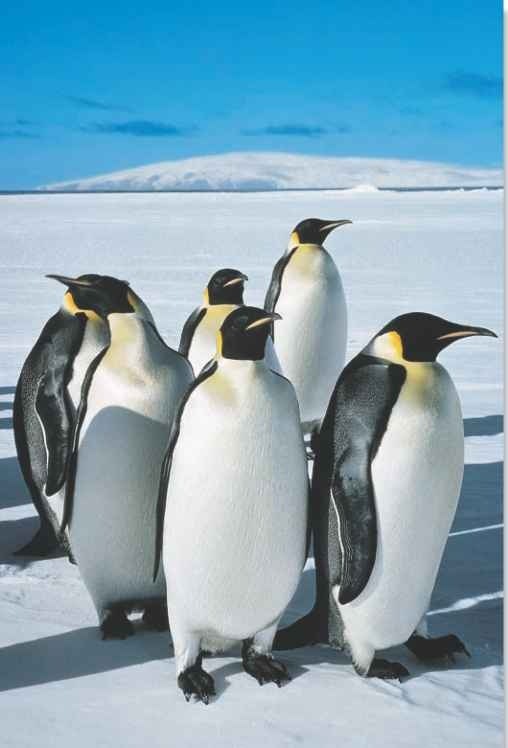ORDER
Sphenisciformes
FAMILY
Spheniscidae
GENUS & SPECIES
KEY FEATURES
• Dense, waterproof plumage and nearly an inch-thick layer of fat provide insulation
• Hunting beneath surface ice, it can swim after prey for nearly 20 minutes, diving to depths of about 1,600′
• Males huddle together for warmth in vast colonies (up to 40,000 birds) as they incubate their eggs throughout the Antarctic winter
WHERE IN THE WORLD ?
Inhabits the icy coastline of Antarctica and neighboring island coasts; it sometimes travels hundreds of miles out to sea when feeding; largest colonies are located around the Ross Sea
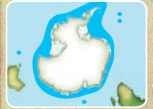
Lifecycle
The emperor penguin spends its entire life in the coldest region on Earth. Other birds share its habitat on a part-time basis; only the emperor penguin lays its eggs on ice.
HABITAT
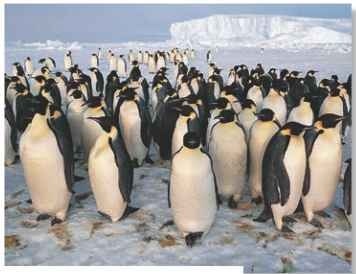
A Subzero survivor
The penguin has been observed in temperatures as low as -76°F.
The pack ice and inhospitable waters surrounding Antarctica are home to the penguin. The bird establishes its enormous breeding colonies (rookeries) mainly at sea level, on stable sea ice. The rookery site can be close to shore or up to 10 miles out to sea, among closely packed, grounded icebergs. Sites are chosen where the ice won’t break up in the long winter-breeding season; some birds have traveled over 60 miles to reach a suitable location.Very occasionally, rookeries are established on dry-land sites (rocky headlands or shingle spits).
CONSERVATION
The emperor penguin is numerous (population estimated at up to 175,000 pairs) and currently unthreatened. However, many experts are concerned that increasing human activity in Antarctica may change this. Commercial fishing could endanger the food supply; aircraft flying low over the coast intrude upon the activity of penguin colonies.
BEHAVIOR
The emperor penguin’s first priority is to keep warm. It’s helped by its 0.8″-thick layer of body fat and dense, insulating plumage, but even these physical adaptations aren’t enough of a defense against extreme temperatures and almost ceaseless, biting wind. In its desolate, icy habitat, the penguin seeks whatever shelter it can find, taking refuge from wind in an ice cliff or low, snow-clad hill.
During the breeding season, males keep warm by huddling together while females hunt.
Creature comforts A protective huddle is one of the penguin’s main defenses against the cold.
BREEDING
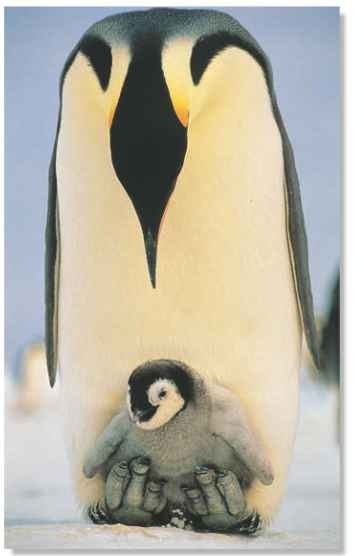
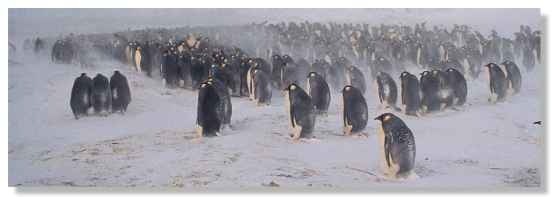
A male penguin will lose up to half his bodyweight while incubating the egg through the winter.
Most of the penguin’s body is covered with 33 feathers to a square inch.
Emperor penguins gather in large, crowded breeding colonies from early March. As soon as the birds arrive they begin courtship displays, forming pairs that will last the whole season.
After laying a single egg, the female passes it to the male, who rolls it onto his feet and covers it with a fold of skin to keep it warm. For the next two months, males press together in the winter gales, until the females return to hatch the eggs. The males, who haven’t eaten all this time, then set off to feed. Once they’ve regained strength they return to resume parental duties.
COLD COMFORT

1 Getting friendly…
The male and female trumpet and bow to each other.The female carries the egg on her feet, waiting to transfer it to the male.
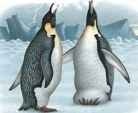
2 Small talk…
They continue their display, trumpeting loudly.They need to learn each other’s calls so they can recognize each other later.

3 Egg change…
The male rolls the egg away from the female and onto his feet.This is done as quickly as possible to keep the egg warm.

4 Winter warming
Males shuffle together, forming constantly moving huddles to keep warm during the two-month incubation period.
FOOD & HUNTING
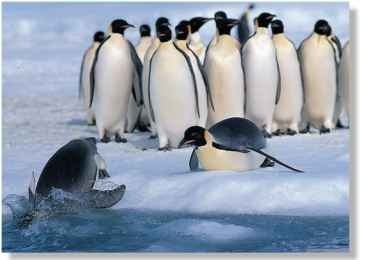
A Time for a bite In an extended dive the emperor penguin may eat several fish or squid.
Waters surrounding Antarctica are as rich in prey as the land is barren and it’s here that the penguin finds its food. Diving beneath the surface, it uses its
flippers to “fly” with ease through the water Able to twist and turn with the grace of a seal, the emperor penguin can pursue its prey underwater for nearly 20 minutes before it has to return to the surface to breathe.
Fish, squid and krill are principal prey of the penguin, although favored prey species vary greatly with location. During offshore foraging trips, the emperor penguin may travel up to 300 miles.
Relying on sight to locate its prey, the penguin hunts only by day and usually only at depths to which sunlight can penetrate. Occasionally, however; it will dive to astounding depths — more than 1,600′ has been recorded — to feed on the seabed.
Profile
Emperor Penguin
Largest of all penguins, the emperor penguin has exchanged mastery of air for the ability to “fly” through water as it dives deep for prey.
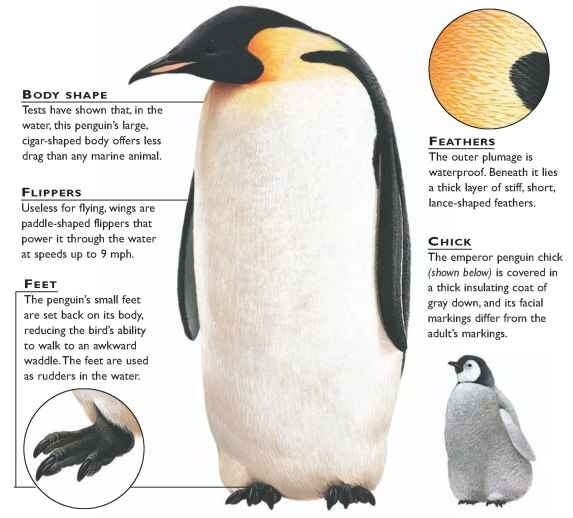
CREATURE COMPARISONS
Standing up to 4′ tall, the emperor penguin is the largest of all penguins. Its great size is an adaptation to the extreme cold of its habitat.The Macaroni penguin, which shares the emperor’s sub-Antarctic environment but at a more northerly latitude, is much smaller The smallest penguin is
the little blue penguin, (about 16″ tall). This species inhabits the warmer waters of New Zealand and southern Australia.

Little blue penguin

Macaroni penguin
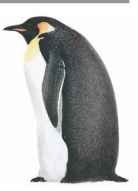
Emperor penguin
| VITAL Weight |
STATISTICS Male up to |
| 88 lbs.; female | |
| up to 70 lbs. | |
| . Length | 3-4.3′ |
| Sexual | 4-8 years |
| Maturity | |
| Mating | April-May |
| Season | |
| Incubation | 65 days |
| Period | |
| Number | 1 |
| [ of Eggs | |
| Fledging | 150 days |
| Period | |
| 1 Breeding | 1 year |
| . Interval | |
| Typical | Squid, fish |
| Diet | and krillif |
| Lifespan | Up to 20 years |
RELATED SPECIES
• Of 17 penguin species in the family Spheniscidae, the closest relative of the emperor penguin and the only other member of the genus Aptenodytes is the king penguin, A. patagonicus. The king.Sill I penguin is almost as tall as the emperor, but weighs about half as much. The king penguin breeds on sub-Antarctic islands, including South Georgia, where it gathers in colonies numbering up to 300,000 pairs.
